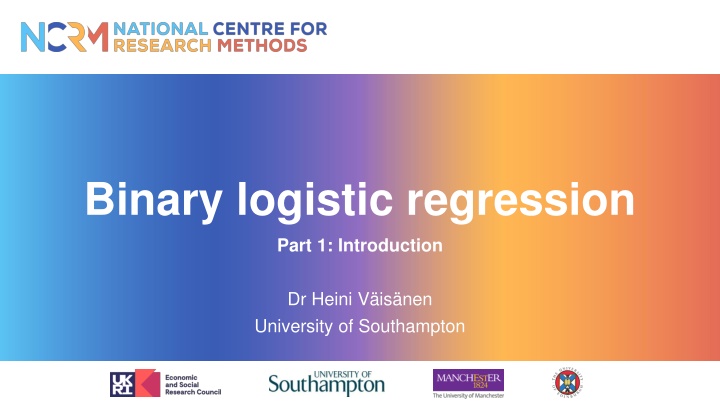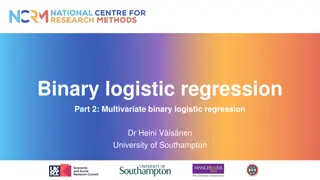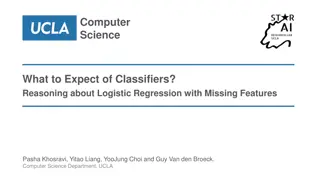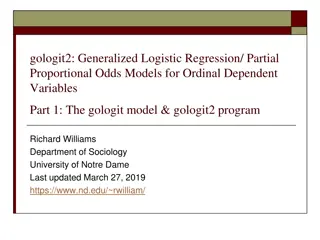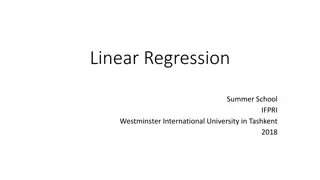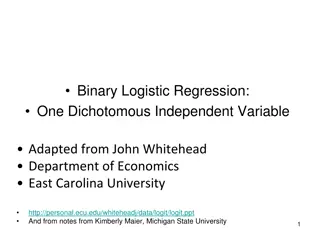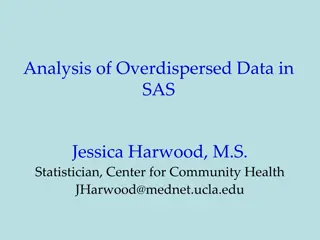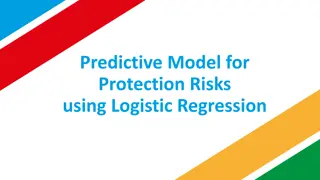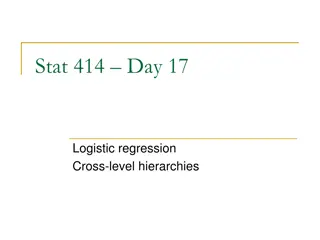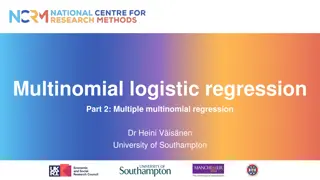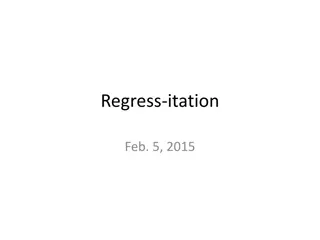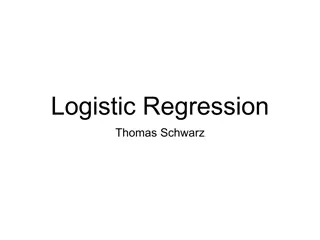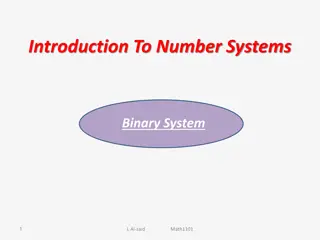Introduction to Binary Logistic Regression: A Comprehensive Guide
Binary logistic regression is a valuable tool for studying relationships between categorical variables, such as disease presence, voting intentions, and Likert-scale responses. Unlike linear regression, binary logistic regression ensures predicted values lie between 0 and 1, making it suitable for modeling probabilities. This technique involves link functions, transformations, and logit functions to establish the relationship between independent and dependent variables effectively.
Download Presentation

Please find below an Image/Link to download the presentation.
The content on the website is provided AS IS for your information and personal use only. It may not be sold, licensed, or shared on other websites without obtaining consent from the author.If you encounter any issues during the download, it is possible that the publisher has removed the file from their server.
You are allowed to download the files provided on this website for personal or commercial use, subject to the condition that they are used lawfully. All files are the property of their respective owners.
The content on the website is provided AS IS for your information and personal use only. It may not be sold, licensed, or shared on other websites without obtaining consent from the author.
E N D
Presentation Transcript
Binary logistic regression Part 1: Introduction Dr Heini V is nen University of Southampton
Outline Binary response Link functions Logistic regression model Parameter interpretation
Binary response & regression models Often in social science we are interested in relationships between categorical variables. E.g. absence/presence of a disease, voting intention, Likert-scale This session introduces binary logistic regression, which can be used to study the association between: A binary outcome (dependent) variable; and Explanatory (independent) variable(s) of any kind
Binary response & regression models We have a binary (dichotomous) response variable Y defined as Y = 1 if success ( yes ) if failure ( no ) 0 We want to model the probability that Y=1
Why not linear regression? Predicted values may lie outside the interval [0, 1]. Assumption of constant variance is violated as variance depends on x through its influence on . var( ) = i(x)[1 i(x)] Standard errors not valid, and conclusions from them misleading.
Solution: Link Functions Good news: we can keep i (x) = 0+ 1x1i+ 2x2i+ + kxki if we model a transformation of i: i= g( i) = 0+ 1x1i+ 2x2i+ + kxki where g(.) is the link function.
What is a link function? We require a link transformation that ensures our fitted values vary between 0 and 1 1. The link function ensures that the expected value of the probability is between 0 and 1 2. When the linear prediction decreases, the probability goes closer to 0 3. When the linear prediction increases, the probability goes closer to 1
Predictor Logit link function logistic regression Transformation: log[ /(1- )] Fundamental concepts: probability = odds = /(1- ) logit( ) = log(odds) = log[ /(1- )] Probability Fig. source: https://commons.wikimedia.org/wiki/File:Logit.png
Characteristics of logits and probabilities 1. If = 0.5 then odds = 0.5/(1-0.5) = 1 and logit = log(1) = 0 2. If > 0.5, then Odds > 1 and logit > 0. 3. If < 0.5, then Odds < 1 and logit < 0. 4. Logit can take any values but is constrained between 0 and 1. 5. can never be exactly 0 or 1.
Example: Birth Weights Is the probability of a normal birth weight, associated with gestational age? Response: Birth weight (BWGHT: 1 = normal, 0 = low). Explanatory: Gestational age in weeks (GAGE). Low birthweight has been defined by WHO as weight at birth of less than 2,500 grams (5.5 pounds).
Descriptive statistics: birth weight N % 17 70.8 Normal birth weight Low birth weight Total 7 29.2 24 100.0
Results: Birth Weights (example) The fitted model with one explanatory variable gestational age (GAGE) is: ????? = 48.9 + 1.31 ???? How is gestational age associated with low birth weight?
Interpretation on logit scale A unit increase in x1increases the logit (log of the odds) by 1 units. ????? = 48.9 + 1.31 ???? For a one week increase in gestational age the log of the odds of a normal birth weight increases by 1.31.
Interpretation on probability scale Predicted probabilities can be computed for any value of GAGE. For example, the estimated probability of a baby with gestational age 39 weeks having a normal birth weight is: exp( 48.9 + 1.31 39) 1 + exp( 48.9 + 1.31 39)= 0.9 ? = The predicted probability of normal birth weight at week 39 is 0.9 (90%)
Interpretation in the odds scale The effects of explanatory variables are multiplicative on the odds scale. A unit increase in x1 multiplies the odds by exp( 1). So, a one week increase in gestational age multiplies the odds of a normal birth by 3.71 [i.e. exp(1.31)]. Alternatively, a one week increase in gestational age increases the odds of a normal birth weight by 100 [3.71 - 1] = 271%
How to report results? For a one week increase in gestational age the log of the odds of a normal birth weight increases by 1.31. The predicted probability of normal birth weight at week 36 was 0.15, whereas at week 39 it is 0.9. Each additional week of gestation increased the odds of normal birth weight by 271%. OR: Each additional week of gestation multiplied the odds of normal birth weight by 3.71. Rarely used (not intuitive) Absolute level of risk / Example at a specific value of X Relative level of risk / Applies to the entire scale of X
